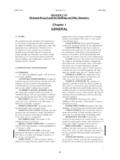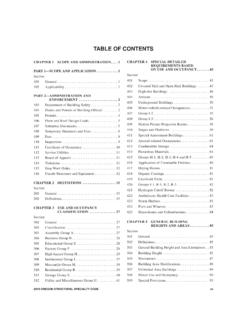Transcription of Guideline for Industrial Steel Storage Rack - safemanitoba.com
1 Prepared by Manitoba Labour and Immigration Workplace Safety & Health Division December 2010 Guideline for Industrial Steel Storage RackEVERYONE'SRESPONSIBILITYW orkplace Safety & Health Divsion 200 401 York Avenue Winnipeg, Manitoba R3C 0P8 December 2010 Guideline for Industrial Steel Storage RackACknoWleDGeMentSSome information and illustrations in this Guideline are courtesy of the Rack Manufacturers Institute and the Building Seismic Safety Council of the National Institute of Building Sciences. Some instructions and material specifications stem from CSA , User Guide for Steel Storage Racks/Standard for the Design and Construction of Steel Storage Safety and Health DivisionGuideline for Steel Storage Racking1table of ContentsIntroduction ..3 Manitoba Workplace Safety and Health Regulation Requirements ..3 Hazard Recognition ..4 Meeting Steel Storage Rack Requirements ..5 Rack Design.
2 5 Types of Racks ..5 Before Purchasing Steel Storage Racks ..6 Products to be Stored ..6 Materials Handling Equipment ..6 Building Characteristics Identification ..6 Rack and Floor layout ..7 Plan and Elevation Drawings ..7 Rack Layouts ..7 Base Plates ..8 Base Plate Design ..8 Types of Base Plates ..8 Rack tolerances and Stability ..9 Vertical Constraints .. 9 Overturning ..9 Deflections ..8 Bracing ..8 Floors ..8 Beam Connections ..8 Building Connections ..10 Safe Loading Connections of the Building ..10 Rating Plates ..10 Drive-in Application ..11 Type of Bolts ..11 Collision Protection ..12 Lighting ..12 Storage Beneath Electrical Lines ..12 Inspection and Maintenance ..13 Inspection Program ..13 Frequency of Inspections ..13 Damaged Racks ..13 Damage Identification and Classification ..13 Repairs and Corrective Actions ..14 Stacking Materials ..15 Bricks or Other Masonry Building Materials.
3 15 Structural Steel Materials ..15 Bagged or Loose Materials ..15 Storing Outdoors ..1510 Tips for Rack Safety ..15 Illustration of Typical Rack Components ..16 Workplace Safety and Health DivisionGuideline for Steel Storage Racking2 Workplace Safety and Health DivisionGuideline for Steel Storage Racking3 IntRoDUCtIonThis Guideline provides general information on the design, installation and use of Steel Storage racks. Because design and installation requirements may differ widely (ex: custom-engineered or specialized racking), it is important to follow the manufacturer s recommendations. Workplace Safety and Health Regulation RequirementsThe Workplace Safety and Health Act and Part 7 of the workplace safety and health regulation ( 217/2006) require employers to ensure that all workplace materials, equipment, machines and tools are stored in a safe 7 of the workplace safety and health regulation states:Design of (1) An employer must ensure that all racks and frames used to store materials, equipment, machines or tools are: (a) designed, constructed and maintained to support the load placed on them; and (b) placed on firm foundations that can support the (2) An employer must ensure that commercially manufactured racks and frames are installed, used and maintained in accordance with the manufacturer s specifications.
4 (3) An employer must ensure that racks that exceed a 3:1 height-to-depth ratio are suitably anchored, externally braced or properly secured to a building or (4) An employer must ensure that all racks and frames used outdoors to store materials, equipment, machines or tools are designed, constructed and maintained to support loads placed on them by wind , wind gusts and other environmental Safety and Health DivisionGuideline for Steel Storage Racking4 HAZARD ReCoGnItIonBe aware that the following hazards may exist when using Steel Storage racks to store materials, equipment, machines and tools at the workplace: worker slips and falls from and around the racking during operations and maintenance overturning of the rack because of incorrect height-to-depth ratio (of the entire rack) failure of the racking structure because of vertical constraints, deflections, beam connections and other stability factors collision of moving equipment with the racking system overloading of the racking system if amount of product stored exceeds capacity of the racking Hazards may also exist under the following conditions.
5 Improper specifications poor installation no inspection or maintenance improper repairs unknown capacityWorkplace Safety and Health DivisionGuideline for Steel Storage Racking5 MeetInG Steel Storage RACk ReQUIReMentSRack DesignSteel Storage racks must be designed and put together according to the manufacturer s requirements or the requirements of a professional and frames used outdoors to store materials, equipment, machines or tools should be designed, put together and maintained to support loads placed on them including wind , wind gusts and other environmental following Standards apply to the design of Steel Storage racks: CAN/CSA-S 136, North American Specification for the Design of Cold-Formed Steel Structural Members CAN/CSA-S16, Limit States Design of Steel Structures S16S1-05, Supplement #1 to CAN/CSA-S16-01, Limit States Design of Steel Structures and replacement pages issued June 2003 and December 2003 as Update #1 and Update #2 to CAN/CSA-S16-01, Limit States Design of Steel Structures incorporated into the original 2001 standard CAN/CSA User Guide for Steel Storage Racks/Standard for Design and Construction of Steel Storage Rackstypes of RacksRack types include: bulk Storage rack pallet racks ( Storage rack) cantilever racks drum Storage racks stacking racks special purpose racks Workplace Safety and Health DivisionGuideline for Steel Storage Racking6 BeFoRe PURCHASInG Steel Storage RACkSFind out the following information before purchasing Steel Storage racks for the workplace.
6 Products to be stored material handling equipment to be used characteristics of the building in which the Storage rack system is to be placedProducts to be stored: Get the characteristics of both the product and pallet that will be used to store it. Find out if the pallets being used for Storage are structurally handling equipment: Learn the manufacturer s specifications for material handling equipment used with the Storage system. Use the manufacturer s specification for material handling equipment to establish recommendations for operating characteristics Facility drawing: Examine the appropriate architectural and mechanical drawings, including a plan view and an elevation of the area where the racks will be installed. If building drawings are unavailable, take accurate measurements and create a scale drawing of the area proposed for Storage rack loading; Building owners or employers must ensure the floor is able to support loads imposed by the Storage rack.
7 Examination by a professional engineer may be required. It may be necessary to obtain approval from the landlord or building owner before installing Storage racks on a slab. The Storage rack manufacturer or designer must determine Storage rack column loads imposed on the floor Safety and Health DivisionGuideline for Steel Storage Racking7 RACk AnD FlooR lAYoUtCreate a layout of the proposed racking system and total floor area used before installing Steel Storage racks at the workplace. This helps ensure adequate clearance and working space for safe movement and Storage of and elevation DrawingsPlan and elevation drawings should include: dimensions for all parts of the rack system right-angle stacking and intersecting aisle requirements building clearances (including all mechanical systems) reference to a specific location within the buildingDrawings should identify loads on buildings or structures from the racking : The building or structure must be able to support loads imposed on it by the racking to rack configurations may change their capacity to handle loads.
8 Before making any changes, consult a professional engineer or the rack manufacturer. Rack layoutRack layouts should consider interaction with the building and building system, the material handling equipment, productivity issues and damage adequate clearances for the following: between pallets; between pallets and frames (side clearances) between pallets and the underside of beams (lift off clearance) pallet overhang (loads over pallets and pallets over beams) forklift operations clearance for lift trucks or other powered mobile equipment to pass each other in the aisles, if applicable access to doorsWorkplace Safety and Health DivisionGuideline for Steel Storage Racking8 BASe PlAteSAll rack columns must be equipped with appropriate base plates. Proper base plates provide uniform transfer of the column load to the floor. The rack manufacturer or designer can supply data on the size and pressure exerted under the bearing plates for each type of upright and setup.
9 This will confirm whether the floor can withstand the anticipated load. (Figures 1a and 1b illustrate types of base plates.) Guidance is provided in CSA Standard , User Guide for Steel Storage Plate DesignA base plate must provide for anchorage and be designed to support the entire profile of the column placed on base plate must transfer the column load in a uniform manner to the supporting structure (floor).note: The Canadian Standards Association (CSA) does not provide design criteria for floors that support Storage racks. Bearing plates are placed under each postFigure 1aFigure 1bA continuous bearing plate joining the two postsWorkplace Safety and Health DivisionGuideline for Steel Storage Racking9 RACk toleRAnCeS AnD StABIlItYVertical ConstraintsRack capacity and rating depends on plumb or vertically straight rack installation. Install the vertical parts of the racks according to design specifications.
10 Maximum tolerance is mm per 3 m of height (1/2 in. per 10 ft. of height). A rack not installed and maintained plumb is subject to stresses that will reduce capacity and stability. overturningThe height-to-depth ratio of the entire rack should not exceed 3:1 measured from the floor to the top of the rack unless the rack is suitably anchored, externally braced or properly secured to the building structure. Placing racks back to back and connecting them will increase their stability. Figure 2 illustrates the height-to-depth ratio. DeflectionsAt maximum working load, the deflection of rack beams must not exceed 1/180th of the span of the beam. For example, if the span of the beam is 4 m ( ft), the maximum deflection allowed is 22 mm (.87 in).BracingDiagonal bracing of the racking systems depends on design considerations and varies from one racking system to another. Diagonal bracing must ensure the stability of the columns.

